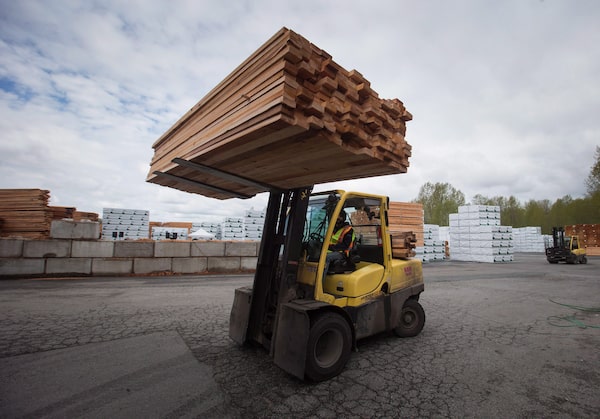
A worker uses a forklift to move lumber at the Partap Forest Products mill in Maple Ridge, B.C., on Tuesday, April 25, 2017.DARRYL DYCK/The Canadian Press
B.C. lumber producers are bracing for a tough 2019 amid concerns over Canada-China trade, the U.S. housing market and American tariffs on Canadian softwood.
The long-term opportunity for boosting lumber exports to China remains huge, despite recent trade tensions, B.C. forestry executives say.
Don Kayne, chief executive of Vancouver-based Canfor Corp., travelled to China in December as part of a B.C. forestry delegation of more than 20 industry representatives. British Columbia accounts for 97 per cent of Canadian lumber exports to China.
B.C. Forests Minister Doug Donaldson and other officials with the provincial government took part in the first two stages of the trip to South Korea and China. The government delegates postponed their plans to visit China days after authorities arrested Huawei Technologies Co. Ltd. chief financial officer Meng Wanzhou on Dec. 1 as she was transiting through Vancouver International Airport.
But delegates from Canfor and other B.C. forestry firms such as West Fraser Timber Co. Ltd., Interfor Corp., Conifex Timber Inc. and Tolko Industries Ltd. forged ahead with the final leg in China, promoting lumber and other products.
“China is a very important export market for Canfor and the forest industry,” Mr. Kayne said in an e-mailed statement from Beijing before returning to Canada. “We have had positive meetings with senior Chinese government officials and customers as we continue to explore opportunities to expand the uses of wood products and pulp.”
In an interview before embarking on the trade mission, Mr. Kayne said he is undaunted by short-term disruptions and stock-price volatility. “We’re looking out five years and 10 years. We’re looking at how do we build this company for the future, from a diversification point of view and strategic aspects,” he said.
On Dec. 11, Ms. Meng was released on $10-million bail. She has been living since then at one of her two Vancouver homes, and is under an array of court-imposed conditions such as wearing a GPS ankle-bracelet and obeying an 11 p.m. curfew. The United States alleges she committed fraud in relation to U.S. trade sanctions against Iran.
Over the past decade, B.C. producers have been striving to reduce their reliance on the American market, with China and Japan becoming the top two customers in Asia for B.C. wood products. The U.S. housing market that boomed in recent years has cooled off. Experts forecast that new residential construction in the United States will grow at a slower pace in 2019 than formerly thought.
As well, the long-running softwood dispute between Canada and the United States is expected to continue into 2019 and 2020. The U.S. Department of Commerce collected final countervailing and anti-dumping tariffs averaging 20.23 per cent against most Canadian lumber producers in 2018.
Adding to the Canada-U.S. uncertainty, lumber prices are in a slump. Benchmark two-by-fours made from western spruce, pine and fir decreased to US$328 for 1,000 board feet in December, down 47 per cent when compared with US$622 in June, according to Madison’s Lumber Reporter.
“Prices haven’t found strength and log cost/supply constraints are not going away anytime soon,” RBC Dominion Securities Inc. analyst Paul Quinn said in a research note.
British Columbia is by far Canada’s largest lumber exporter into the United States, with a 53.1-per-cent share of the total value in 2017, followed by Quebec (18.3 per cent), Alberta (11.5 per cent), Ontario (7.8 per cent) and New Brunswick (6.5 per cent).
Susan Yurkovich, president of the B.C.-based Council of Forest Industries, said she is optimistic about the prospects for long-term growth in lumber exports to China, which is B.C.'s second-largest customer. In 2017, China accounted for 16 per cent of B.C. lumber sold to foreign buyers while the United States remained the largest purchaser with 63 per cent of the total export value.
China’s market has become increasingly important, ordering $1.07-billion worth of B.C. lumber in 2017, compared with $177-million in 2008. But the value of B.C. softwood shipped to China fell in 2018 compared with 2017 as the sharp drop in lumber prices in the second half of 2018 took its toll.
“Our industry is highly resilient,” said Ms. Yurkovich, who joined Mr. Kayne and other B.C. forestry executives during the swing through China. “Asia in general, and China in particular, continues to be a very important market for B.C. wood products.”
Guy Saint-Jacques, a senior fellow at the University of Alberta’s China Institute and a former Canadian ambassador to China, said it’s understandable that the forestry industry delegation decided to continue onto China since meetings were scheduled months ago, but other Canadian executives will likely take a wait-and-see attitude on travel plans in 2019. “The Canadian government has to use all available communication channels to try to impress on the Chinese that we have to lower the temperature because we run the risk of causing lasting damage to the relationship,” he said.
Capital Economics senior economist Stephen Brown cautions that Canada’s forestry sector is among the industries exposed to potential retaliation from China. “If tensions escalate much further, we suspect the most likely response from China will be measures to boycott Canada’s exports,” Mr. Brown said in a research note.